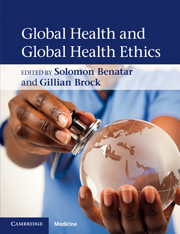Book contents
- Frontmatter
- Contents
- List of contributors
- Introduction
- Section 1 Global health, definitions and descriptions
- Section 2 Global health ethics, responsibilities and justice: some central issues
- Section 3 Analyzing some reasons for poor health
- Section 4 Shaping the future
- 20 The Health Impact Fund: how to make new medicines accessible to all
- 21 Biotechnology and global health
- 22 Food security and global health
- 23 International taxation
- 24 Global health research: changing the agenda
- 25 Justice and research in developing countries
- 26 Values in global health governance
- 27 Poverty, distance and two dimensions of ethics
- 28 Teaching global health ethics
- 29 Towards a new common sense: the need for new paradigms of global health
- Index
- References
22 - Food security and global health
Published online by Cambridge University Press: 01 March 2011
- Frontmatter
- Contents
- List of contributors
- Introduction
- Section 1 Global health, definitions and descriptions
- Section 2 Global health ethics, responsibilities and justice: some central issues
- Section 3 Analyzing some reasons for poor health
- Section 4 Shaping the future
- 20 The Health Impact Fund: how to make new medicines accessible to all
- 21 Biotechnology and global health
- 22 Food security and global health
- 23 International taxation
- 24 Global health research: changing the agenda
- 25 Justice and research in developing countries
- 26 Values in global health governance
- 27 Poverty, distance and two dimensions of ethics
- 28 Teaching global health ethics
- 29 Towards a new common sense: the need for new paradigms of global health
- Index
- References
Summary
Introduction
Food is a basic human right. It is also a lens through which we can observe and measure progress in health as well as the protection of human dignity. In 2000, the United Nations (UN) agreed to eight Millennium Development Goals (MDGs). The first goal (MDG 1) was the eradication of extreme poverty and hunger by 2015. To achieve the food security dividend, as we have called it, we need to think about the world as it is in terms of hungry people and about what is most needed if global food security is to be achieved. This chapter examines the issue of food security and global health. The link between the two is obvious – if we achieved food security for all, we would advance the prospects of global health for all, arguably beyond any other single intervention.
What is food security?
It is helpful to begin with clarification of terms. The 1996 Rome Declaration on Food Security states, “food security exists when all people, at all times, have physical and economic access to sufficient safe and nutritious food to meet their dietary needs and food preferences for a healthy and active life.” Food insecurity is a lack of food security. The Food and Agriculture Organization (FAO) uses the words “hunger,” “undernourishment,” and “food insecurity” interchangeably (FAO, 2009a).
Food insecurity is a term that is applied at a range of levels from the individual through to global.
- Type
- Chapter
- Information
- Global Health and Global Health Ethics , pp. 261 - 273Publisher: Cambridge University PressPrint publication year: 2011



